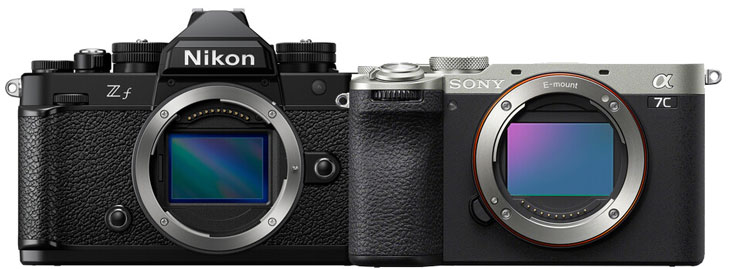
First, let’s look at the body design of the two cameras. The Nikon ZF features a retro body design with extensive manual controls. So, if you’re a photographer, the Nikon ZF is highly recommended, especially from a design perspective.
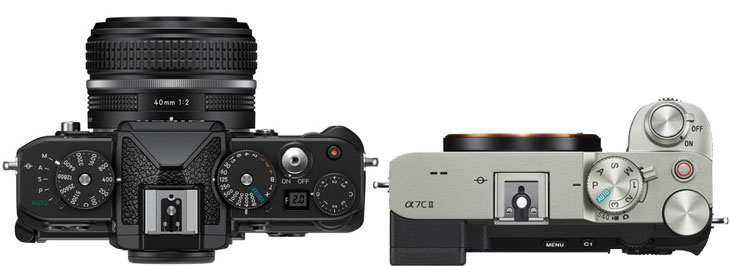
What I love about the Nikon ZF, apart from its extensive manual control, is the placement of the electronic viewfinder and its higher resolution. Not only does the EVF have a higher resolution, but the display of the camera also features a higher resolution compared to Sony’s A7 C Mark II.
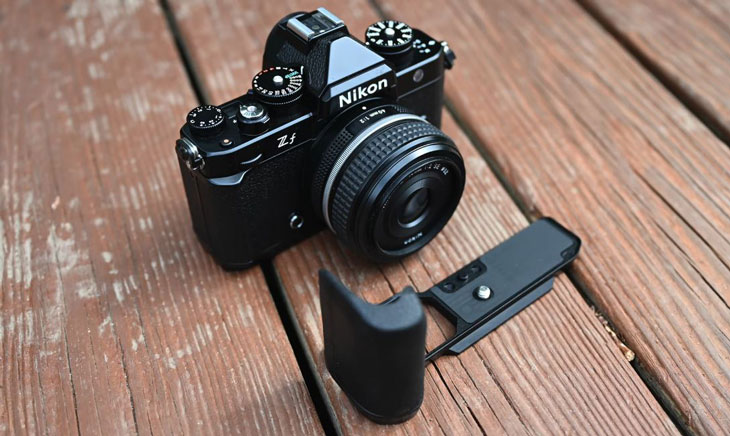
You might feel that the hand grip isn’t as perfect as you’d expect in a modern camera. With the ZF, you can buy an external hand grip at a very reasonable price if you feel the need.
Unfortunately, the Sony A7 C Mark II features a single card slot. In contrast, the Nikon ZF has a MicroSD card slot along with a UHSII SD card slot. As a photographer, you get an extra slot to save your JPEG files if you wish to.
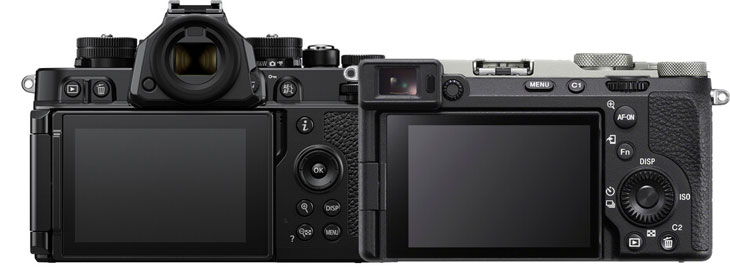
Both cameras lack a joystick, but in the Nikon ZF, you have the option to use your display screen as a touchpad for selecting or moving autofocus points while looking at the viewfinder.
That’s another interesting feature that we have inside the Nikon ZF camera. Overall, design-wise, I highly recommend that if you are a photographer, you should go with the Nikon ZF camera.
| Lens Mount | Nikon Z | Sony E |
| Sensor Resolution | Actual: 25.28 Megapixel Effective: 24.5 Megapixel |
Actual: 34.1 Megapixel Effective: 33 Megapixel |
| Image Sensor | 35.9 x 23.9 mm (Full-Frame) CMOS | 35.9 x 23.9 mm (Full-Frame) CMOS |
| Image Stabilization | Sensor-Shift, 5-Axis | 8 Stops | Sensor-Shift, 5-Axis | 7 Stops |
| Built-In ND Filter | None | None |
| Capture Type | Stills & Video | Stills & Video |
Now let’s look at the internal core specifications of both cameras:
1. 24 megapixels versus 33 megapixels
As we all know, the Nikon ZF camera uses a 24-megapixel APS-C sensor from the Nikon Z6 Mark II camera and the Sony Mark II camera uses the sensor from Sony’s A7 IV.
Does this resolution difference matter that much? Should we change our minds and forget about the design preferences that we are getting with the Nikon ZF camera?
To find out, we have compared images from the Nikon Z6 Mark II camera with those from the Sony A7 IV and tried to find out the difference between the two.
Side by Side Comparison
We are comparing two images side by side. On one side, we have the Nikon Z6 Mark II camera, and on the other, we have the Sony A7 IV. These two cameras were chosen for comparison because the Nikon ZF camera uses the same sensor as the Nikon Z6 Mark II, and the Sony A7C Mark II uses the same sensor as the Sony A7 IV.
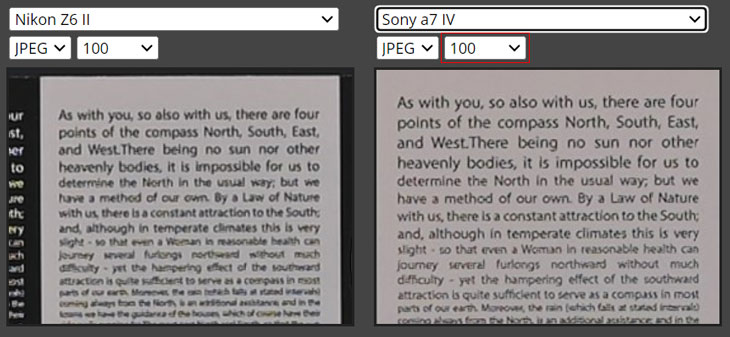
From the two images, it is quite clear that the Sony A7 IV camera’s 33-megapixel sensor captures slightly more detail. Therefore, those who are using the Sony A7 Mark II camera will certainly observe more detail compared to the Nikon Z6 Mark II.
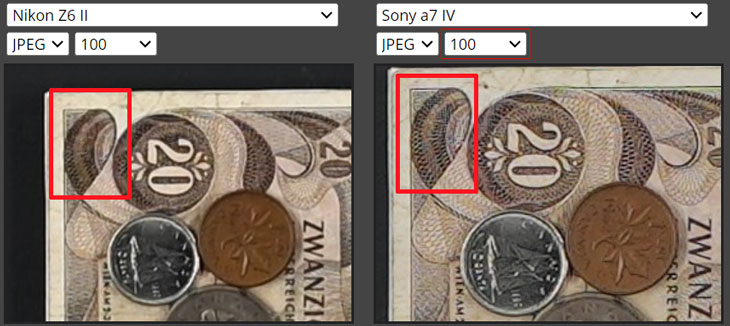
2. Multi-Shot 96 MP High-Resolution Images
One of the major key differences between the two is that the recently announced Nikon ZF camera can capture 96-megapixel high-resolution images. However, these images should be taken with a tripod. Once the shot is done, it should be uploaded to the Nikon NX software to merge all the images. This means that the camera will not merge the images; it will only capture them. It’s also not recommended to use a handheld when capturing 96-megapixel resolution images.
Get Sony A7C Mark II from B&H Store | Get Nikon Zf from B&H Store
Get Sony A7C from Amazon.com | Get Nikon Zf from Amazon.com
Best Camera for Capturing More Details
Before we jump in and discuss the different aspects of the auto-focusing system or perhaps the continuous burst speed of a camera, it’s a fact of the matter, and it’s also visible from the comparisons that we have done with the images, that the Sony A7C Mark II camera is able to capture slightly more details compared to the Nikon ZF.
The Nikon ZF does offer 96-megapixel images, but with the condition that you have to use your camera on a tripod. This means that if you are a studio photographer, the Nikon ZF camera will undoubtedly be of great help to you. However, for general purpose photography, the Sony A7 will capture slightly more detail compared to the Nikon ZF. This is the difference between the two.
| Focus Type | Auto and Manual Focus | Auto and Manual Focus |
| Focus Mode | Automatic, Full-Time Servo, Manual Focus, Single-Servo AF, Touch AF & Shutter | Continuous-Servo AF, Manual Focus, Single-Servo AF |
| Autofocus Points | Photo, Video Contrast Detection, Phase Detection: 273 |
Photo Contrast Detection, Phase Detection: 759 Video Phase Detection: 627 |
| Autofocus Sensitivity | -10 to +19 EV | -4 to +20 EV |
3. Auto Focusing
Let’s discuss the auto-focusing system of both cameras. For the first time, we are seeing the auto-focusing algorithms of the Nikon Z8 and Nikon Z9 in a camera under $2000.
If we compare the auto-focusing points, on one side we have 759 in the Sony A7C Mark II, and on the other side, in the Nikon ZF, we have only 273. At the same time, being a Sony camera, we have no doubt about the focusing capabilities of the Sony A7C Mark II.
The Nikon ZF’s auto-focusing has very much improved and now has the ability to track 9 different types of subjects or objects in its tracking mode. So more or less, both cameras are the best in their own class.
| Shutter Type | Electronic Shutter, Mechanical Focal Plane Shutter | Electronic Shutter, Mechanical Focal Plane Shutter |
| Shutter Speed | Mechanical Shutter 1/8000 Up to 30 Seconds in Manual Mode 1/8000 Up to 4 Seconds in Shutter Priority Mode Electronic Shutter 1/8000 to 30 Seconds in Manual Mode 1/8000 to 4 Seconds in Shutter Priority Mode |
Mechanical Shutter 1/4000 to 30 Seconds Electronic Shutter 1/8000 to 30 Seconds 1/8000 to 1 Second in Movie Mode |
| Bulb/Time Mode | Bulb Mode, Time Mode | Bulb Mode |
| ISO Sensitivity | Photo 100 to 64,000 in Manual Mode (Extended: 5 0 to 204,800) Video 100 to 51,200 in Manual Mode (Extended: 204,800) |
Photo 100 to 51,200 in Manual Mode (Extended: 50 to 204,800) 100 to 12,800 in Auto Mode Video 100 to 51,200 in Manual Mode (Extended: 50 to 102,400) 100 to 12,800 in Auto Mode |
| Metering Method | Center-Weighted Average, Matrix | Aperture Priority, Auto, Manual, Program, Shutter Priority |
| Exposure Modes | Aperture Priority, Auto, Manual, Program, Shutter Priority | -5 to +5 EV (1/3, 1/2 EV Steps) |
| Exposure Compensation | -5 to +5 EV (1/3 EV Steps) | -3 to 20 EV |
| Metering Range | -4 to 17 EV | 2500 to 9900K Presets: AWB, Cloudy, Daylight, Flash, Fluorescent, Manual, Overcast, Shade, Tungsten |
| Continuous Shooting Speed | Up to 15 fps Mechnical and up to 30 Fps Elec. | Up to 10 fps for up to 44 Frames (Raw) / 1000 Frames (JPEG) |
4. Burst Speed
The continuous burst speed of both cameras is quite different. The Nikon ZF is able to shoot up to 15 frames per second with a mechanical shutter, and while shooting with the mechanical shutter, you will not have any rolling effect with the camera up to 15 FPS. After 15 FPS, the electronic shutter gets activated and now with the electronic shutter, you can shoot up to 30 frames per second.
With the Sony A7C Mark II camera, the maximum burst speed of the camera is limited to 11 frames per second with a mechanical shutter. Although you do get a higher resolution sensor at 33MP, if you are a wildlife photographer, then without a doubt, I would recommend you to go with the Nikon ZF camera since you have two options: one is a faster mechanical shutter with 15 FPS and the other is the electronic shutter with a speed up to 30 frames per second.
5. Upto – 10 EV AF sensitivity in Nikon ZF
One key factor to consider before making a decision is the low-light focusing capability of the cameras. The Nikon ZF camera is able to focus up to -10 EV at an aperture of f1.2, making its focusing capability in near-dark situations best in its class. On the other hand, the Sony A7C Mark II camera has an auto-focus sensitivity of -2 EV. This information could be crucial depending on your photography needs.
6. Nikon Zf uses a Touchscreen as a Touchpad
Another advantage of the Nikon ZF camera is that you can use your touchscreen as a trackpad while looking through the viewfinder. This means you can focus on your subject while looking at the electronic EVF, and at the same time, you can use your touchscreen display as a trackpad to move your auto-focusing points. With the Sony A7C Mark II camera, this is not possible as it neither has the touch and track capability of the Nikon ZF nor a joystick controller on the rear side of the camera.
Verdict – Best Camera for Photographers
If you consider all factors, not only image quality but also body design, higher resolution, and the advanced features of the Nikon Z8 and Nikon Z9 cameras, such as the out-of-focus system with -10ev autofocus sensitivity, the ability to use the touchscreen as a touchpad for shifting autofocus points, and the ability to shoot at a continuous speed of up to 15 frames per second with a mechanical shutter and up to 30 frames per second with an electronic shutter, then without a doubt, the Nikon Z8 and Z9 are better cameras compared to the Sony Alpha 7C mark II.
If image quality is your primary concern and other factors such as the design, focusing part of the camera, or the dual card slot are less important to you, and you desire a camera that provides slightly more detail, then the Sony Alpha 7C Mark II is highly recommended. This camera is known for its exceptional image quality, boasting a 33.0MP full-frame Exmor R back-illuminated CMOS sensor. It also offers excellent autofocus and is compact in size. However, it’s always important to consider all aspects of a camera before making a decision.
| Internal Recording Modes | UHD 4K (3840 x 2160) at 23.98/25/30.00 fps 1920 x 1080 at 23.98/25/29.97/50/59.94/100/120 fps |
XAVC HS 4:2:2/4:2:0 10-Bit 3840 x 2160 at 23.98/50/59.94 fps [30 to 200 Mb/s] XAVC S 4:2:2/4:2:0 8/10-Bit 3840 x 2160 at 23.98/25/29.97/50/59.94 fps [60 to 200 Mb/s] XAVC S-I 4:2:2 10-Bit 3840 x 2160 at 23.98/25/29.97/50/59.94 fps [240 to 600 Mb/s] |
| External Recording Modes | None | 4:2:2 8/10-Bit via HDMI UHD 4K (3840 x 2160) at 23.98/25/29.97/50/59.94 fps |
| Recording Limit | Up to 125 Minutes | None |
| IP Streaming | Yes | MJPEG, UVC/UAC 3840 x 2160 at 12.5p, 14.99p, 25p, 30p 1920 x 1080 at 25p, 30p, 50p, 60p 1280 x 720 at 25p, 30p |
7. Best Camera for Video
When comparing the video capabilities of the Nikon ZF and Sony Alpha 7C Mark II, both cameras can record oversampled 4K videos at 24 and 30 fps. However, the Sony Alpha 7C Mark II, with its 33-megapixel full-frame sensor, is expected to provide slightly more detail in video quality.
In the 4K 60 fps video mode, both cameras crop at 1.5x, meaning that the 4K 60fps is recorded in APS-C format.
The recording time limit for the Sony Alpha 7C Mark II is unlimited, while the Nikon ZF has a recording time limit of 125 minutes in 4K. This is more than sufficient unless you plan to use your mirrorless camera as a security camera.
Both cameras are capable of recording 10-bit videos internally.
The Nikon ZF has a pre-shooting buffer that you can set to timings like 30 seconds, 1 minute, or 1 minute and 30 seconds.
The Sony Alpha 7C Mark II has some videography features absent in the Nikon ZF, such as AI auto framing and a gyroscopic image stabilization mechanism. These features make the Sony Alpha 7C Mark II more helpful for content creators due to its AI autofocusing and auto-framing techniques.
Get Sony A7C Mark II from B&H Store | Get Nikon Zf from B&H Store
Get Sony A7C from Amazon.com | Get Nikon Zf from Amazon.com
Both cameras feature very angle-displays, making them suitable for professional-level content creation.
Verdict – Best Camera for Video
In terms of video resolution, both cameras capture the same video resolution. So, if you’re a photographer as well as a content creator, it might be better to go with the Nikon ZF. However, if you’re solely focused on content creation and prefer a Sony camera, then the Sony Alpha 7C Mark II would be a good choice.
| Media/Memory Card Slot | Slot 1: SD/SDHC/SDXC (UHS-II) Slot 2: microSD/microSDHC/microSDXC |
Single Slot: SD/SDHC/SDXC (UHS-II) |
| Video I/O | 1 x Micro-HDMI (Unspecified Signal) Output | 1 x Micro-HDMI (Unspecified Signal) Output |
| Audio I/O | 1 x 1/8″ / 3.5 mm TRS Stereo Microphone (Plug-in Power) Input | 1 x 1/8″ / 3.5 mm TRS Stereo Microphone Input on Camera Body 1 x 1/8″ / 3.5 mm TRS Stereo Headphone Output on Camera Body |
| Power I/O | None | 1 x USB-C Input/Output |
| Other I/O | 1 x USB-C Input/Output | 1 x USB-C Data Input/Output (Shared with Power Input) |
| Mobile App Compatible | Yes: Android & iOS *As of September 2023: Check with the manufacturer for the most up-to-date compatibility |
Yes: Android & iOS App Name: Creators’ App Functionality: Access Stored Files, Adjust Settings, Remote Control *As of August 2023: Check with the manufacturer for the most up-to-date compatibility |
One of the most important things that you will notice is that the camera is able to have two SD card slots, one is micro SDHC and the other is UHS-II standard.
| Display Size | 3.2″ | 3″ |
| Resolution | 2,100,000 Dot | 1,036,800 Dot |
| Display Type | Articulating Touchscreen LCD | Tilting Touchscreen LCD |
One of the good things associated with the Nikon ZF camera is that you will get a higher resolution display as well as a higher resolution that really helps a photographer if they would like to have a better experience and better shooting experience with a camera.
| Type | Built-In Electronic | Built-in electronic (OLED) |
| Size | 0.5″ | 0.39″ |
| Resolution | 3,690,000 Dot | 2,359,296 Dot |
| Eye Point | 21 mm | 22 mm |
| Coverage | 100% | Approx. 0.7x |
| Magnification | Approx. 0.8x | -4 to +3 |
Flash
| Built-In Flash/Light | No | No |
| Maximum Sync Speed | 1/250 Second | 1/160 Second |
| Flash Compensation | -3 to +1 EV (1/3 EV Steps) | -3 to +3 EV (1/3, 1/2 EV Steps) |
| Dedicated Flash System | iTTL | Shoe Mount |
General
| Battery Type | 1 x EN-EL15c Rechargeable Lithium-Ion | 1 x NP-FZ100 Rechargeable Lithium-Ion (Approx. 530 Shots) |
| Shoe Mount | 1 x Hot Shoe | 1 x Intelligent Hot Shoe |
| Tripod Mounting Thread | 1 x 1/4″-20 Female (Bottom) | 1 x 1/4″-20 Female (Bottom) |
| Material of Construction | Magnesium Alloy | Magnesium Alloy |
| Dimensions (W x H x D) | 5.7 x 4.1 x 1.9″ / 144 x 103 x 49 mm | 4.9 x 2.8 x 2.5″ / 124 x 71.1 x 63.4 mm |
| Weight | 22.2 oz / 630 g (Body Only) | 1.1 lb / 514 g (With Battery, Recording Media) 15.1 oz / 429 g (Body Only) |






